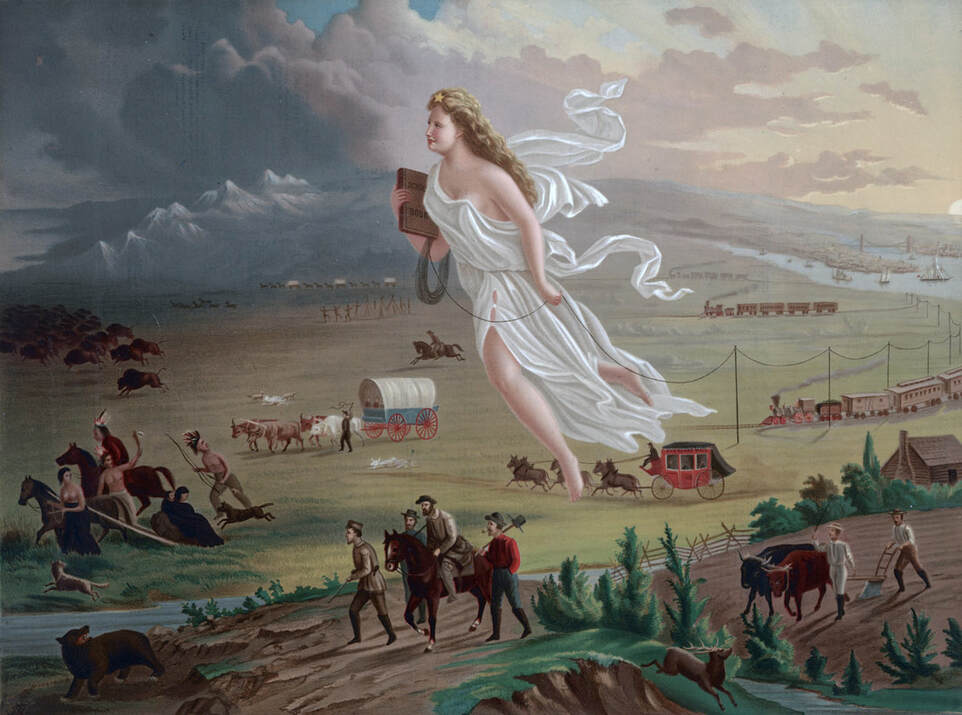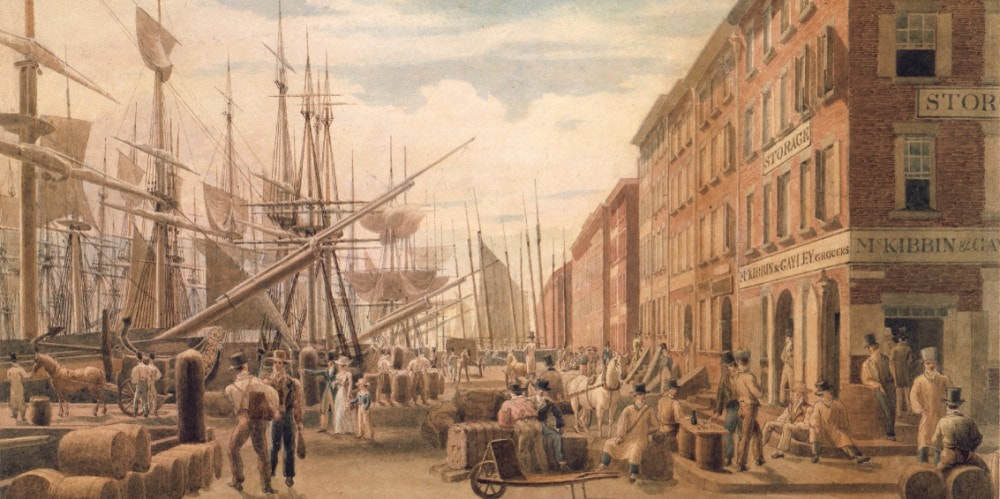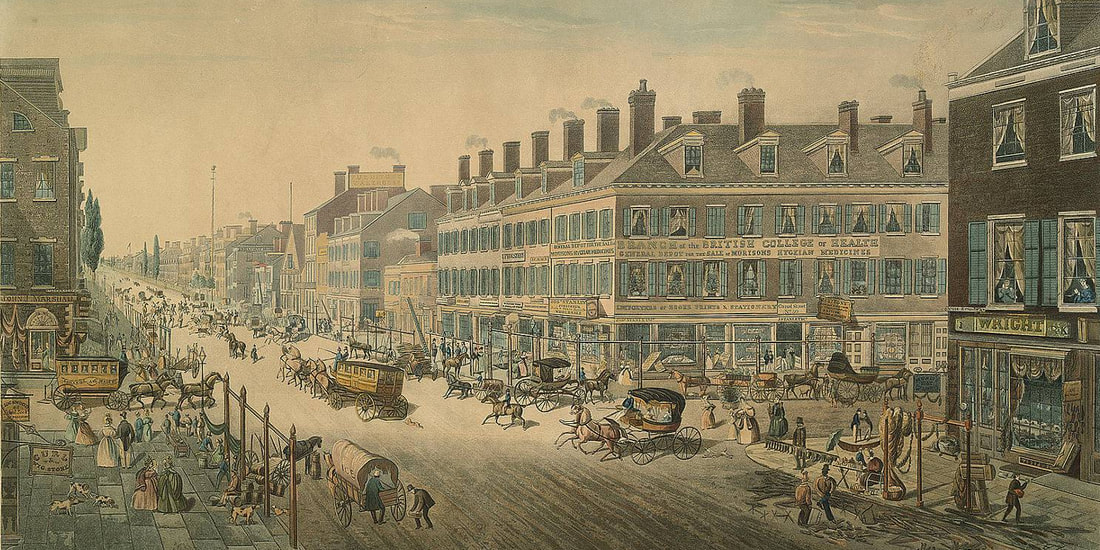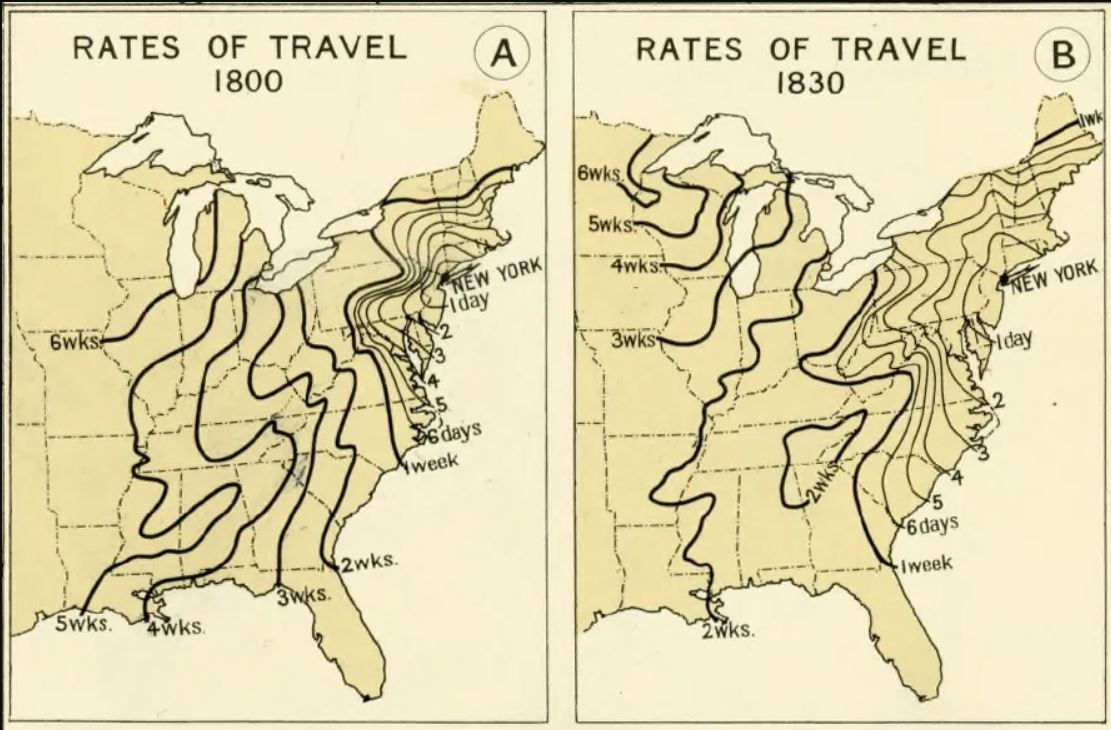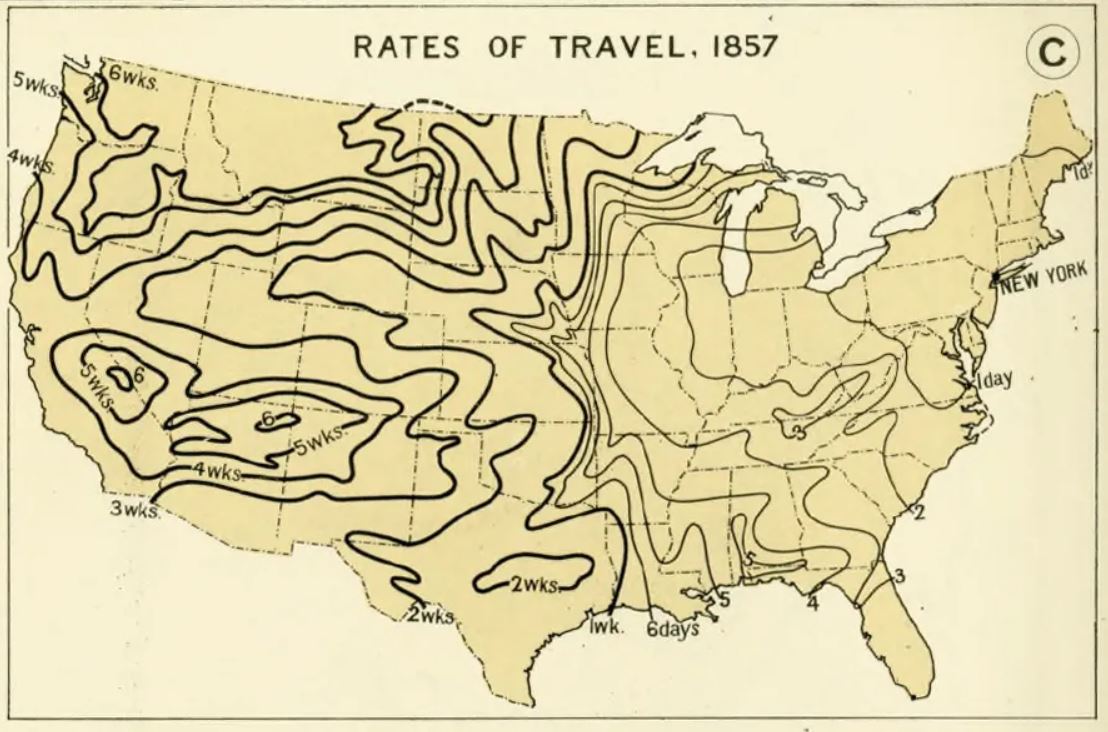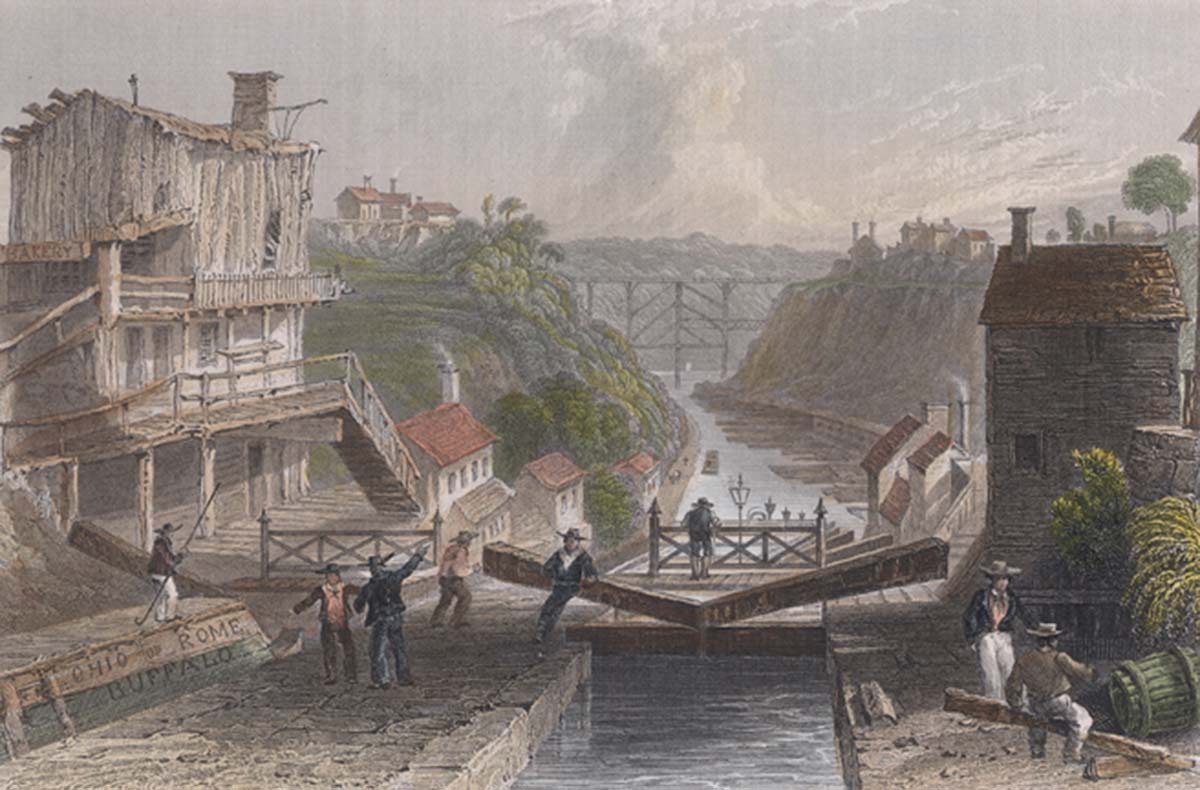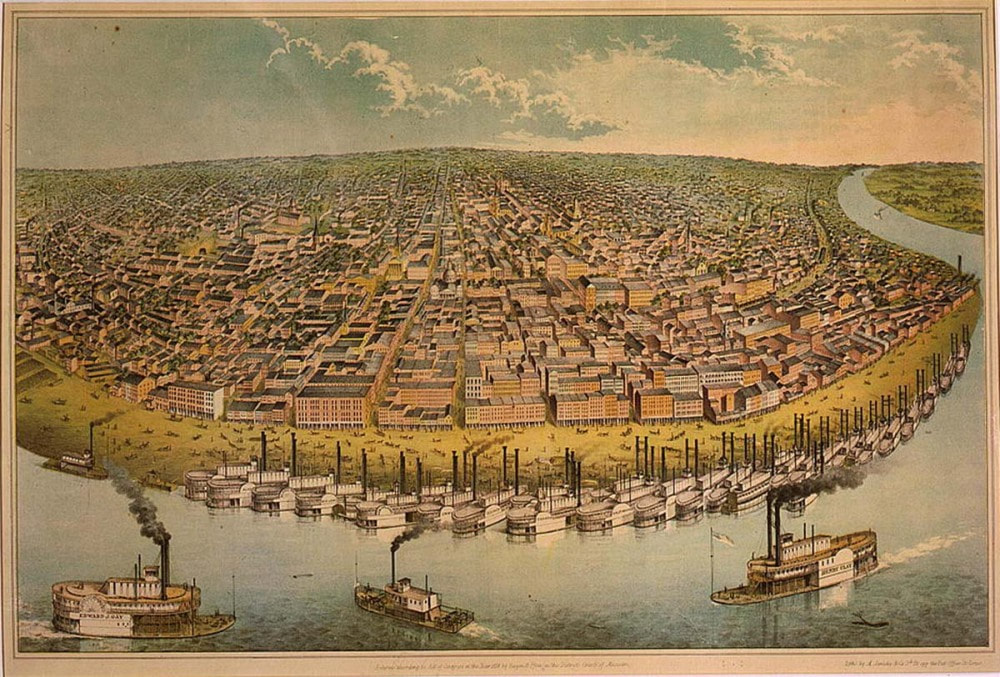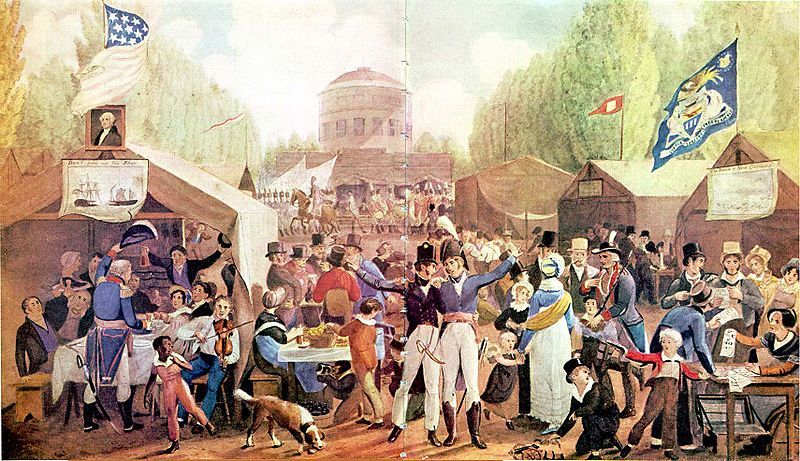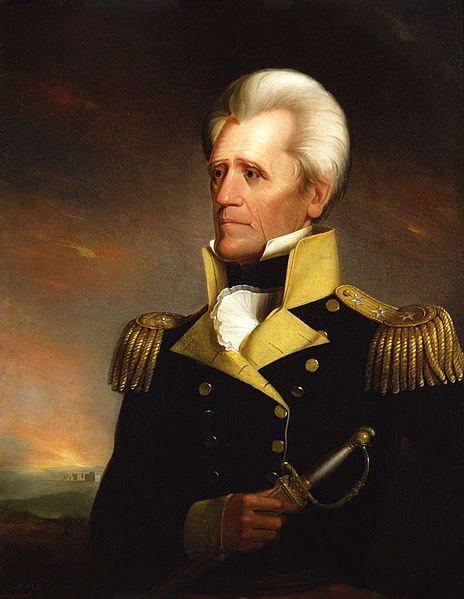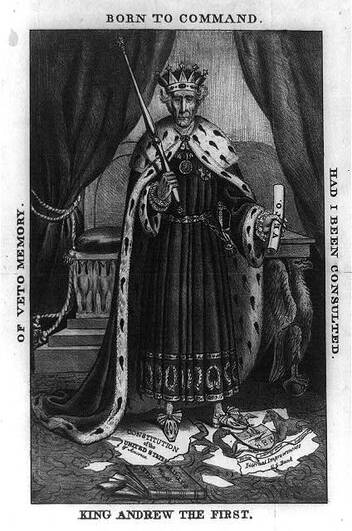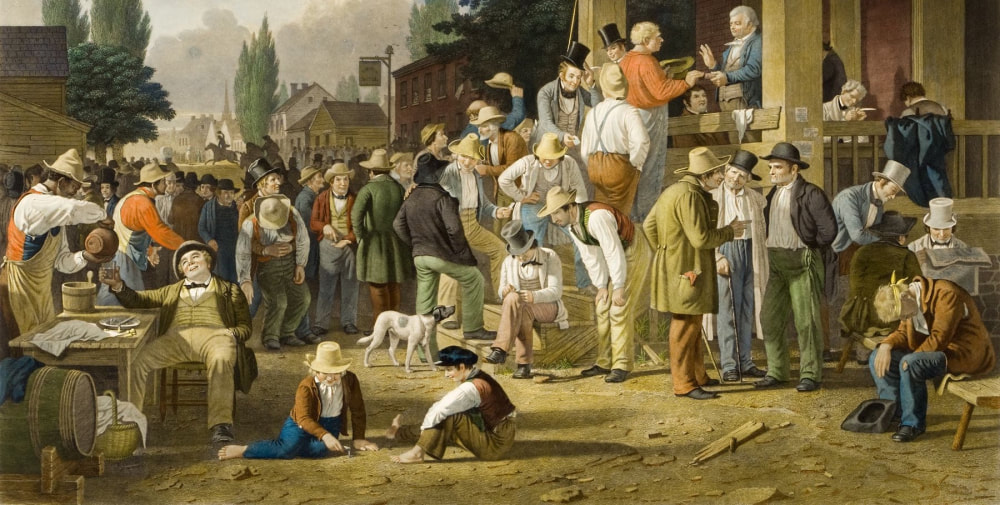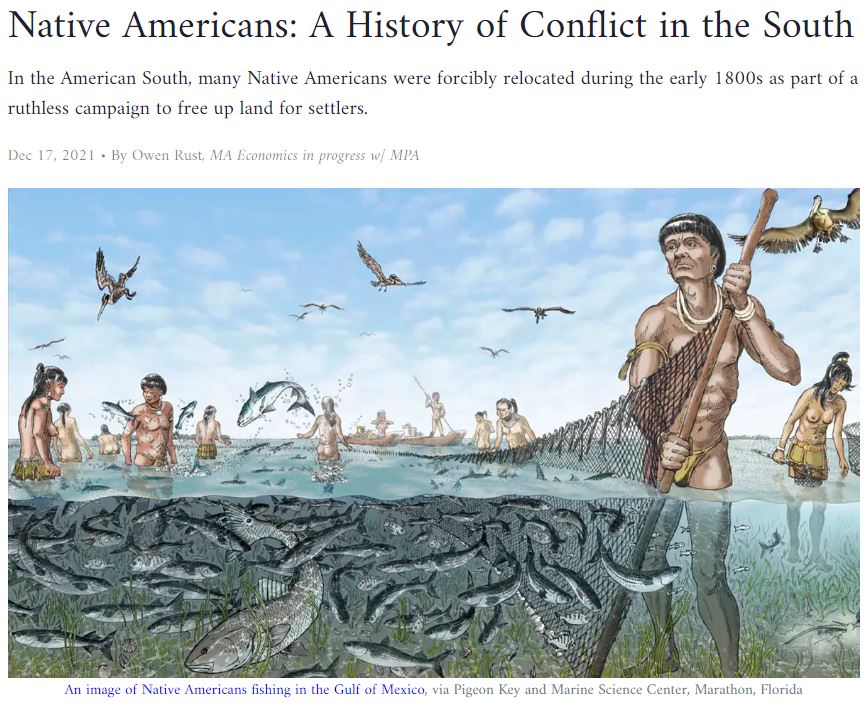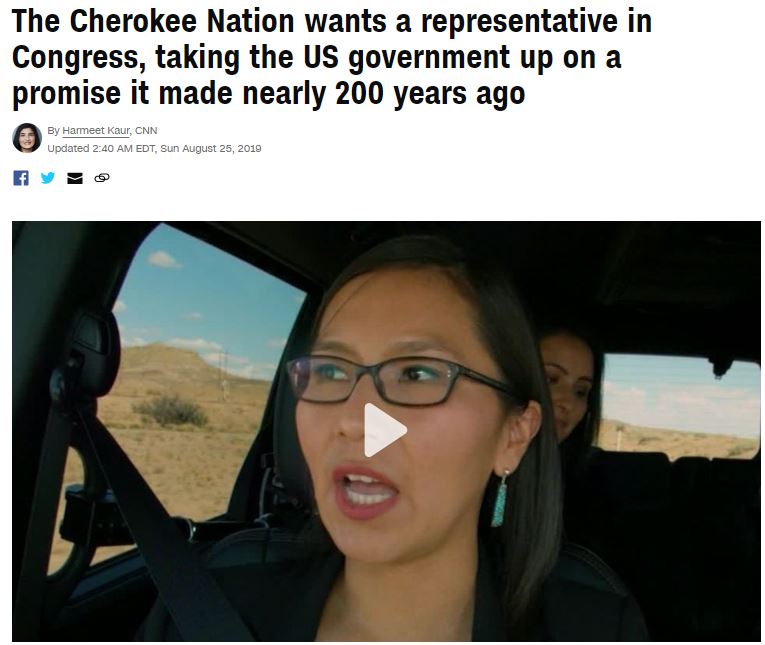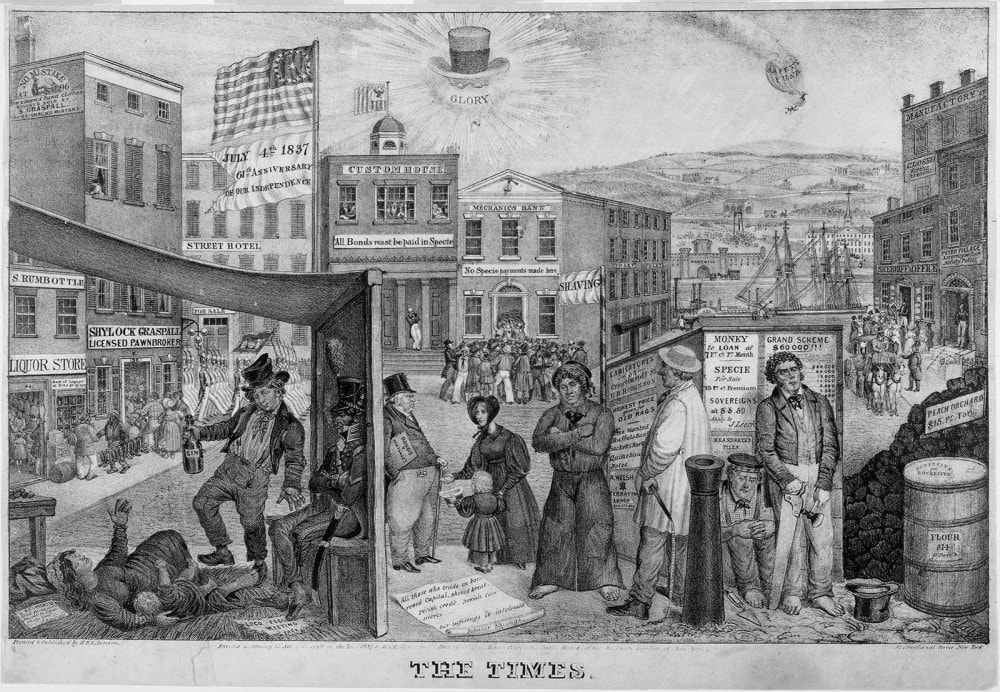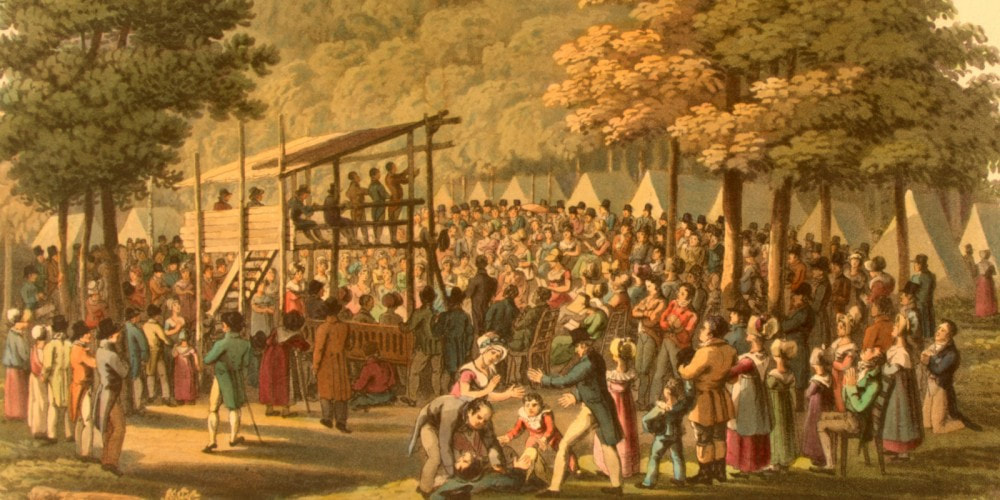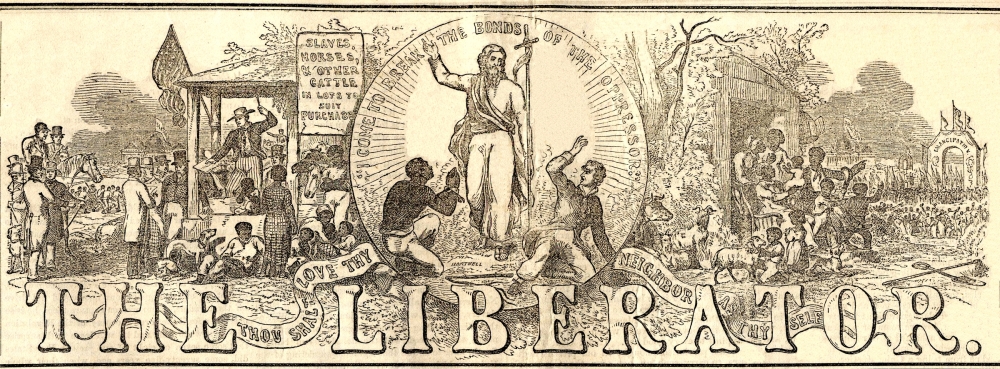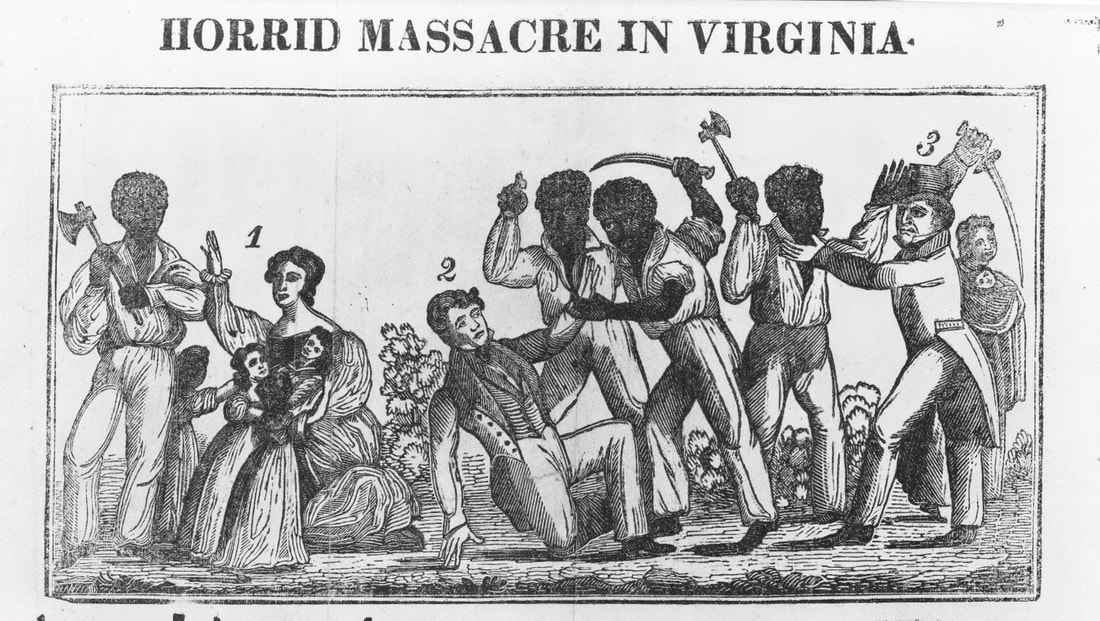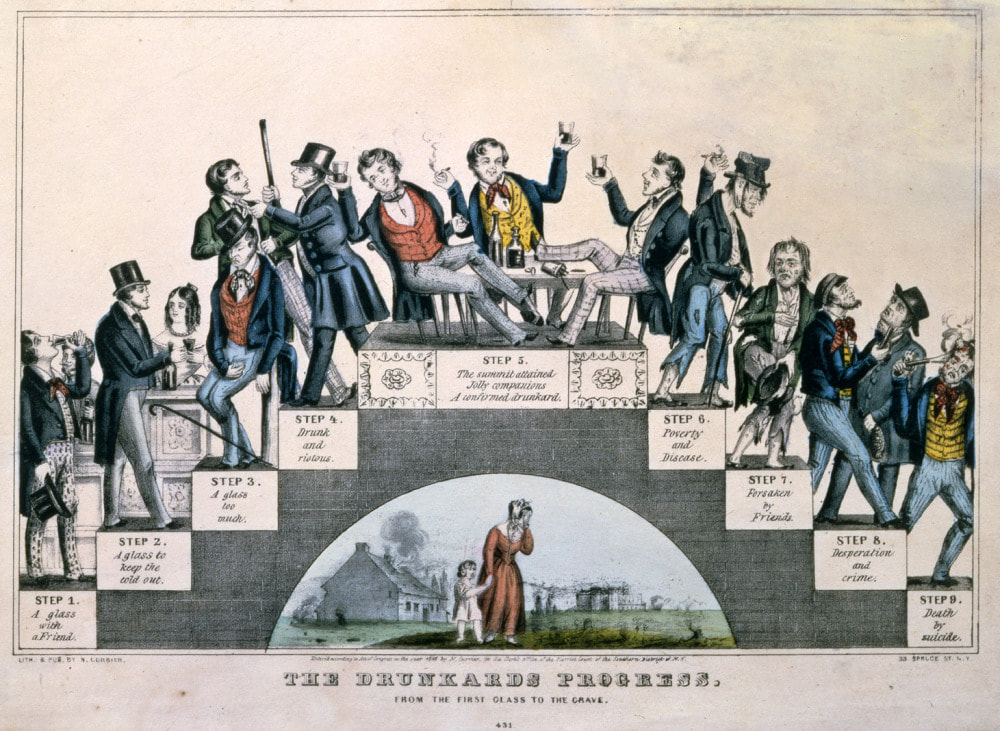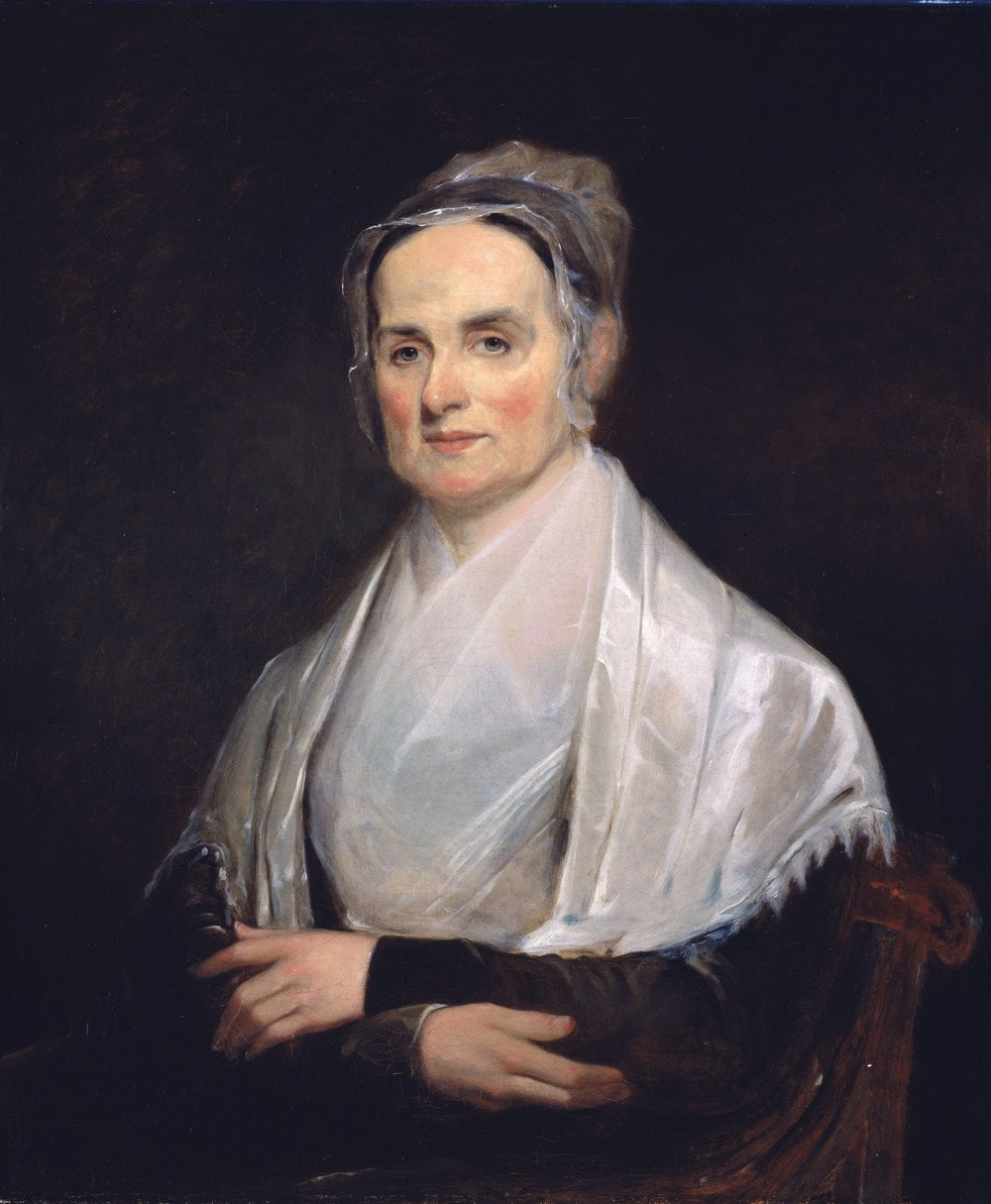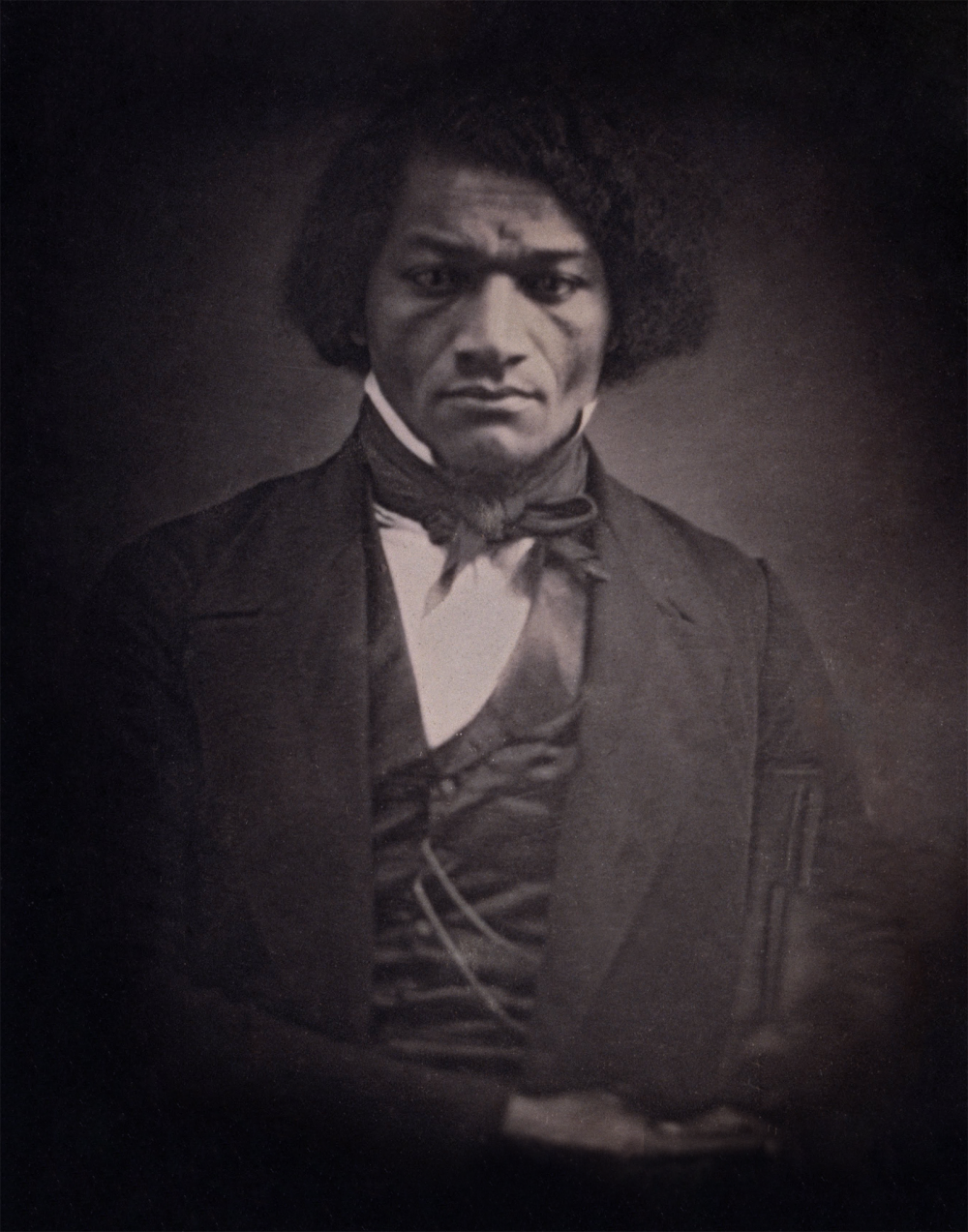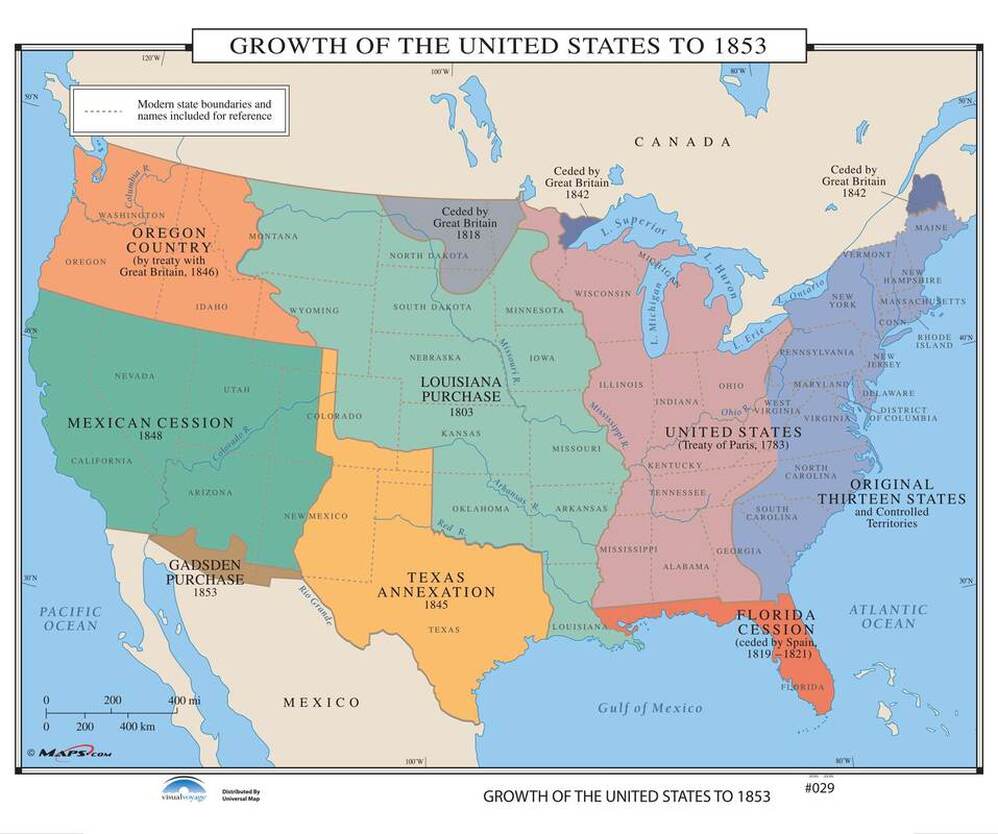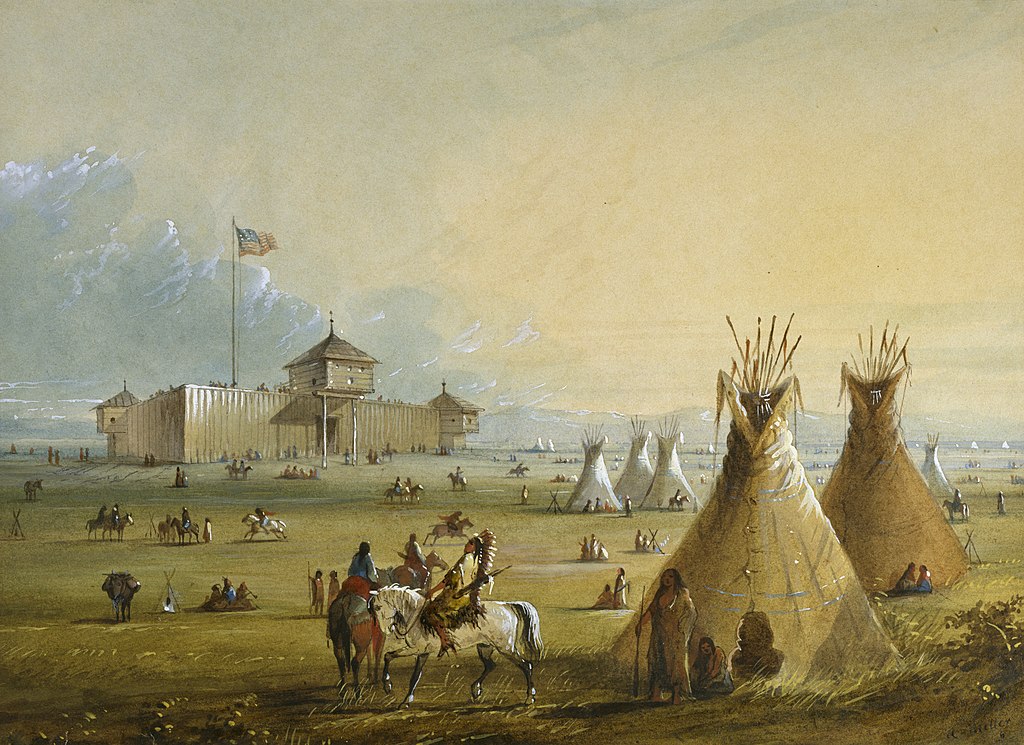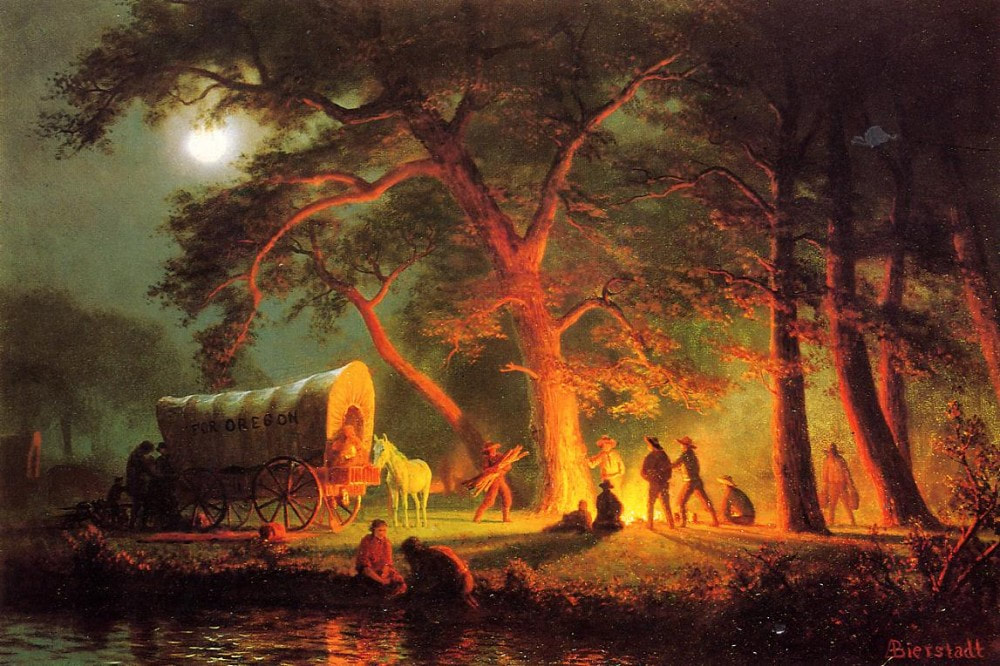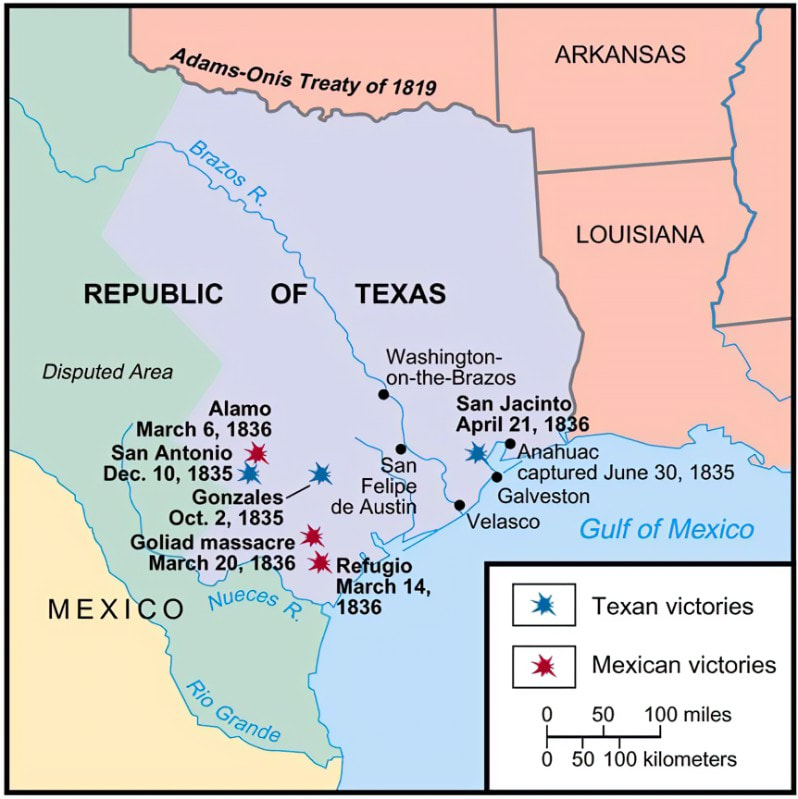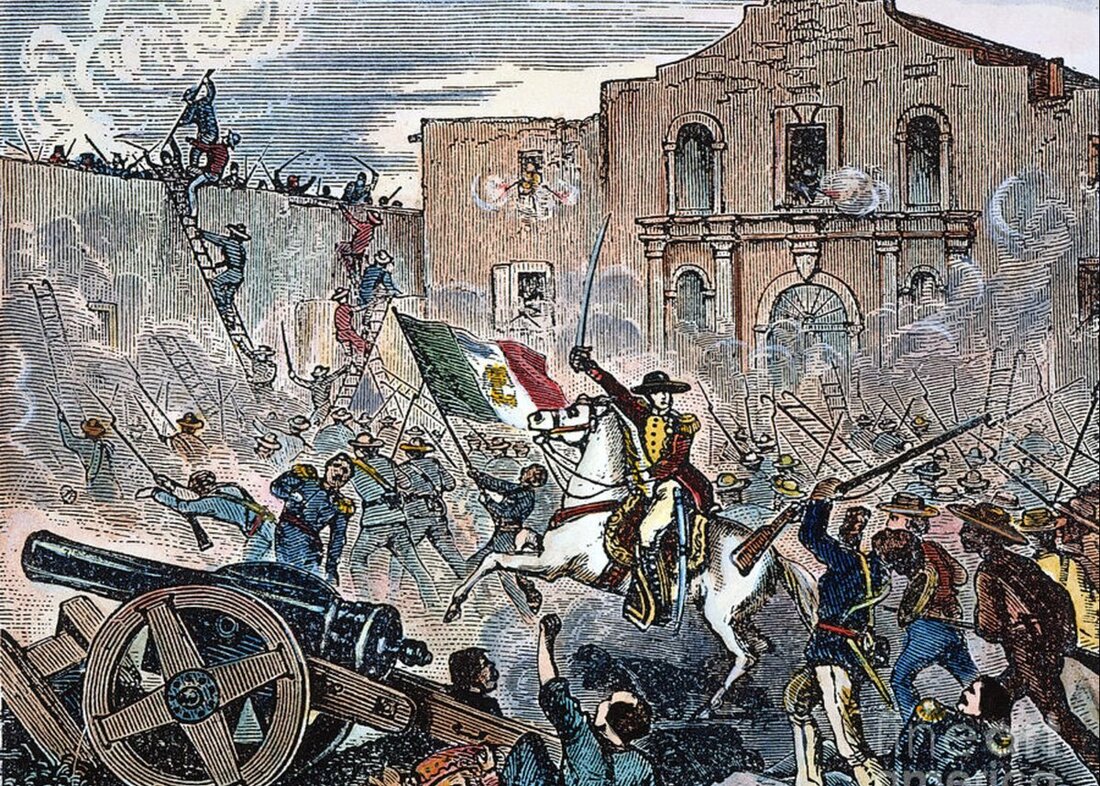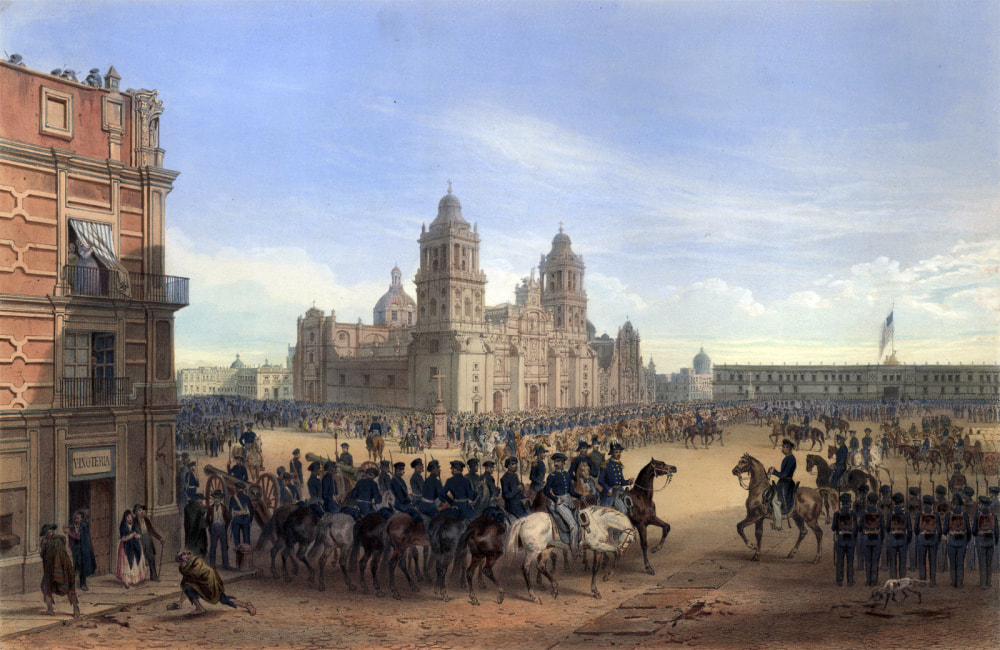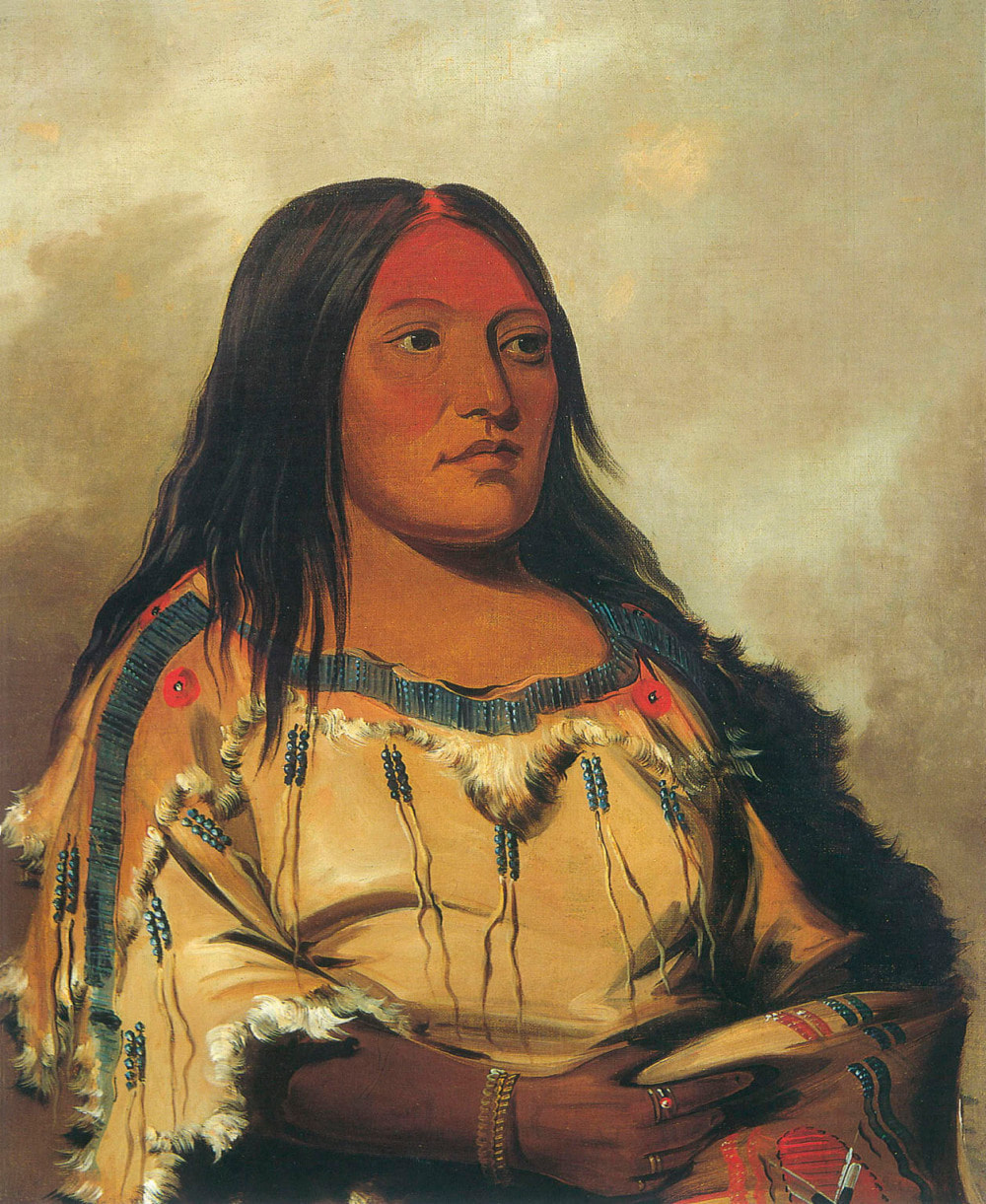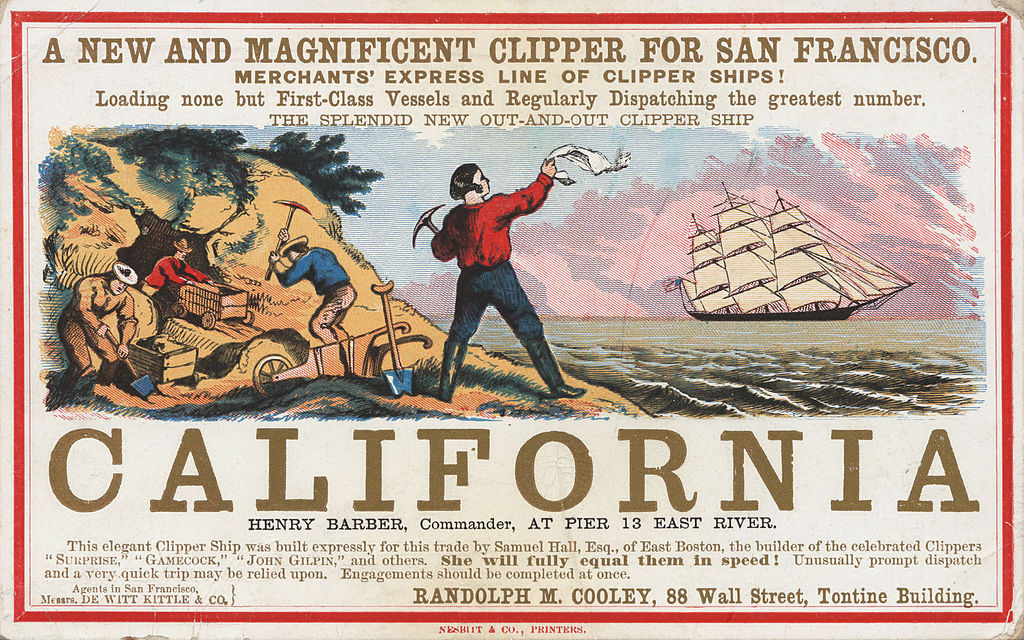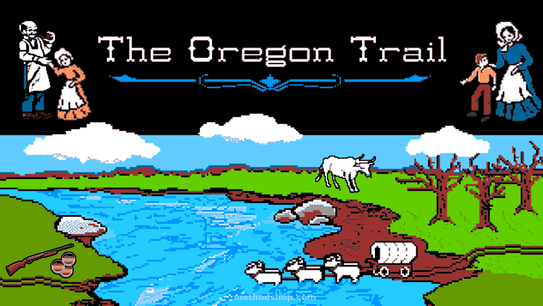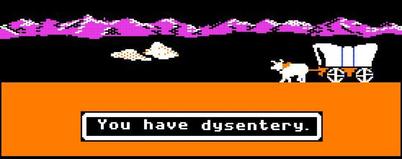Expansion
1810s-1840s
Artistic propaganda like this promoted the national project of manifest destiny. Columbia, the female figure of America, leads Americans into the West and into the future by carrying the values of republicanism (as seen through her Roman garb) and progress (shown through the inclusion of technological innovations like the telegraph) and clearing native peoples and animals, seen being pushed into the darkness. John Gast, American Progress, 1872.
Contents
Expansion, 1810s-1840s:
Industrial Revolution
|
Industrial Revolution Quizlet
|
Review:
- How did transportation developments and industrialization affect the nation’s economy?
- How did the North and South differ during the first half of the 1800s?
The Era of Good Feelings
Independence Day Celebration, 1819
|
The Era of Good Feelings Quizlet
|
Review:
- How did domestic and foreign policies reflect the nationalism of the times?
Jacksonian Democracy
Andrew Jackson portrayed himself as the defender of the common man, and in many ways he democratized American politics. His opponents, however, zeroed in on Jackson’s willingness to utilize the powers of the executive office. Unwilling to defer to Congress and absolutely willing to use his veto power, Jackson came to be regarded by his adversaries as a tyrant (or, in this case, “King Andrew I”.) Anonymous, c. 1832.
George Caleb Bingham, The County Election
|
Jacksonian Democracy Quizlet
|
Many Americans blamed the Panic of 1837 on the economic policies of Andrew Jackson, who is sarcastically represented in the lithograph as the sun with top hat, spectacle, and a banner of “Glory” around him. The destitute people in the foreground (representing the common man) are suffering while a prosperous attorney rides in an elegant carriage in the background (right side of frame). Edward W. Clay, “The Times,” 1837
Review:
- What changes did Andrew Jackson represent in American political life?
- What major political issues emerged during the 1830s?
Reform Movements
“Camp Meeting of the Methodists in N. America,” 1819
|
William Lloyd Garrison published the abolitionist newspaper The Liberator.
|
Nat Turner led a slave rebellion in Virginia in August 1831. Rebel slaves killed 55-65 people.
|
Nathaniel Currier, “The Drunkard’s Progress.” 1846
Review:
- How did the Second Great Awakening affect life in the United States?
- What were the main features of the public school, penitentiary, and temperance reform movements?
- How did reformers try to help enslaved people?
- What steps did American women take to advance their rights in the mid-1800s?
Westward Expansion
|
Fort Laramie as it looked prior to 1840
|
The great environmental and economic potential of the Oregon Territory led many to pack up their families and head west along the Oregon Trail. The Trail represented the hopes of many for a better life, represented and reinforced by images like Bierstadt’s idealistic Oregon Trail. Albert Bierstadt, Oregon Trail (Campfire), 1863
|
“General Scott’s entrance into Mexico.” Lithograph. 1851. Originally published in George Wilkins Kendall & Carl Nebel, The War between the United States and Mexico Illustrated, Embracing Pictorial Drawings of all the Principal Conflicts (New York: D. Appleton), 1851
|
Westward Expansion
|
Westward Expansion Quizlet
American artist George Catlin traveled west to paint Native Americans. In 1832 he painted Eeh-nís-kim, Crystal Stone, wife of a Blackfoot leader
|
Review:
- What were the causes of westward migration?
- How did the revolution in Texas lead to war with Mexico?
- What were the effects of the Mexican-American War and the California Gold Rush?
Assignments and Readings
|
|
Your browser does not support viewing this document. Click here to download the document.
| ||||||
|
|
Your browser does not support viewing this document. Click here to download the document.
| ||||||
|
|
Your browser does not support viewing this document. Click here to download the document.
| ||||||
Seven Maps That Explain the United States' Strategy
Your browser does not support viewing this document. Click here to download the document.
|
| ||||||||||||
| america_story_of_us_ep_3_westward_and_ep_4_division.pdf | |
| File Size: | 106 kb |
| File Type: | |
| 1815-1849_review_guide.pdf | |
| File Size: | 797 kb |
| File Type: | |
| ultimate_guide_to_the_presidents_episode_2.pdf | |
| File Size: | 106 kb |
| File Type: | |
Presidential Ambition: A 19th Century Political Campaign Project
Your browser does not support viewing this document. Click here to download the document.
| presidential_ambition_-_fall_2019.pdf | |
| File Size: | 118 kb |
| File Type: | |
Reform Movement Social Media Campaign
- Inspired by: What U.S. History Would Have Been Like With Hashtags
Your browser does not support viewing this document. Click here to download the document.
| reform_movement_social_media_campaign_-_fall_2019.pdf | |
| File Size: | 81 kb |
| File Type: | |
* PLEASE NOTE - The links in the dating profile section of the assignment are now apparently blocked at school. Please see the picture below for what successful dating profiles look like.
The Oregon Trail
|
The Oregon Trail
|
Primary Sources
Missouri Controversy documents, 1819-1920
Southerners dominated the highest federal offices for the first decades of the United States, as Virginians held the Presidency for nation’s first thirty-two of the first thirty-six years. Northerners resented this dominance and sectional tensions simmered until they threatened to boil over in 1820 when James Tallmadge included the below amendment to Missouri’s application for statehood. Included below is Tallmadge’s amendment; the final act which settled the crisis, at least temporarily; and a private letter from Thomas Jefferson illustrating his reaction to the crisis.
Rhode Islanders protest property restrictions on voting, 1834
Many poor white men gained voting rights, also known as suffrage, for the first time in the 1830s. These changes in American democracy did not take place without conflict. Voting rights in Rhode Island only changed after poor Rhode Islanders raised a militia and threatened violence. Below is the proposal of many of the men who seven years later took up arms to right for voting rights.
Black Philadelphians defend their voting rights, 1838
The expansion of voting rights to poor white men brought a loss of voting rights for black men. Race, rather than class, quickly became the most important social distinction in the United States. Some wealthy black men, like James Forten and Robert Purvis of Pennsylvania, lost voting rights that they previously enjoyed. In this document, Philadelphians protest the loss of their voting rights.
Andrew Jackson’s veto message against re-chartering the Bank of the United States, 1832
President Andrew Jackson, like Thomas Jefferson before him, was highly suspicious of the Bank of the United States. He blamed the bank for the Panic of 1819 and for corrupting politics with too much money. After Congress renewed the bank charter, Jackson vetoed the bill. The following was the message he gave to Congress after issuing his veto. Jackson’s decision was controversial. Some Americans accused him of acting like a dictator to redistribute wealth. Others saw the act as an attack on a corrupt system that only favored the rich.
Frederick Douglass, “What to the Slave is the Fourth of July,” 1852
Frederick Douglass was born into slavery in Talbot County, Maryland in 1818. He was separated from his mother in infancy and lived with his grandmother until he was separated from her as well at age seven. After several attempts, he finally successfully escape slavery in 1838. He became one of the most influential abolitionist speakers and before a crowd of white abolitionists in 1852, he delivered this, one of the greatest abolitionist speeches.
Rebecca Reed accuses nuns of abuse, 1835
In 1834 anti-Catholic rioters burned the Ursuline Convent in Charestown, Massachusetts. In 1835, Rebecca Reed published a memoir about her time staying at the convent. Prior to its publication, rumors existed about Reed’s experience that may have motivated the arsonists. In these documents, we read excerpts from Reed’s account and the response from the convent’s Mother Superior Mary St. George.
Samuel Morse fears a Catholic conspiracy, 1835
Irish immigrants in the early nineteenth century filled jobs created by the Market Revolution. Their arrival provided an important source of labor for a growing economy, but many Americans worried about the influence of these arrivals. Samuel Morse, an inventor who contributed to the development of the telegraph and Morse Code, feared that Irish immigrants represented the front line of a Catholic conspiracy to destroy the United States.
County election painting, 1854
Beginning in the late 1840s, George Caleb Bingham created a series of paintings illustrating American democracy. He was drawn to the energy and near-chaos of speeches, rallies, election days, public announcements of voting results and more. Prior to painting this work, Bingham himself ran for state office in Missouri as a Whig. Here he shows the tumult of a county election day. Children play games, drunkards raise their glass (while political operatives drag inebriated men to the poll), citizens carefully debate the issues, while others study the newspaper. Art historians argue whether Bingham is celebrating or mocking American democracy.
Martin Van Buren cartoon, 1837
This caricature of President Martin Van Buren cloaked in worthless bank notes was created during the Panic of 1837. The artist mocks Van Buren and the policies of his predecessor, Andrew Jackson. The cartoon includes mentions to Jackson’s “Specie Circular,” an order that government officials only accept gold or silver as payment for land and Van Buren’s “Safety Fund,” a program designed to offset the damage of bank failures. A document labeled “Indian claims” also refers to Jackson’s policy of Indian Removal. These and other subtle details reveal the anxieties of economic collapse and the policy differences between Democrats and Whigs.
Revivalist Charles G. Finney emphasizes human choice in salvation, 1836
Charles Grandison Finney left a successful law practice when he believed God called him to become a preacher. He enjoyed great success, particularly in Upstate New York, a region that Finney called “the burned over district.” Finney’s revivals emphasized human action, and he encouraged his converts to join various reform organizations, including avoiding alcohol and eventually opposing slavery.
Dorothea Dix defends the mentally ill, 1843
Dorothea Dix worked as an educator and author until she took up the campaign for improving the treatment for the mentally ill. Struggling with depression and other mental illnesses herself, Dix presented this petition to the Massachusetts state legislature after visiting a number of jails to chronicle abuses.
David Walker’s Appeal to the Colored Citizens of the World, 1829
David Walker was the son of an enslaved man and a free black woman. He traveled widely before settling in Boston where he worked in and owned clothing stores and involved himself in various reform causes. In 1829, he wrote the remarkable Appeal to the Colored Citizens of the World. In it, he exposed the hypocrisies of American claims of freedom and Christianity, attacked the plan to colonize black Americans in Africa, and predicted that God’s justice promised violence for the slaveholding United States.
William Lloyd Garrison introduces The Liberator, 1831
William Lloyd Garrison participated in reform causes in Massachusetts from a young age. In the 1820s he advocated black colonization in Africa and the gradual abolition of slavery. Reading the work of black northerners like David Walker changed his mind. In 1831, he created a newspaper, called The Liberator. The following is the opening essay that Garrison used to explain the purpose of his paper.
Angelina Grimké, Appeal to Christian Women of the South, 1836
Women were active participants in every aspect of the abolitionist movement. In this document, Angelina Grimké, a former Southerner herself, attempts to persuade Southern women of the immorality of slavery. This tactic, called moral suasion, directed the efforts of abolitionists, especially in the 1830s and 1840s.
Sarah Grimké calls for women’s rights, 1838
Antebellum Americans increasingly confined middle-class white women to the home, where they were responsible for educating children and maintaining household virtue. Yet women used these ideas to become more active in the public sphere than ever before, taking prominent roles in all the major reform causes of the era. Women’s participation in the antislavery crusade most directly inspired specific women’s rights campaigns. In this document, Sarah Moore Grimké calls for equality between men and women.
Henry David Thoreau reflects on nature, 1854
The Transcendentalist movement began in Cambridge, Massachusetts in 1836, when a group of Unitarian clergymen formed what later became known as the Transcendental Club. The club met for four years and quickly expanded to include numerous literary intellectuals. Among these were the author Henry David Thoreau. In 1845, Thoreau took up residence at Walden Pond and began to write. The result was Walden, which touted simple living, communion with nature, and self-sufficiency.
The fruit of alcohol and temperance lithographs, 1849
This pair of lithographs, created by Nathaniel Currier (later of Currier & Ives fame), contrasts the “fruits” of abstaining from alcohol to those of indulging in strong drink. It leaves little to the imagination. Intemperance is symbolized by a diseased tree, surrounded by drunks outside of a pawn shop and a woman and her children being thrown out of their home. The lush foliage of temperance, on the other hand, is surrounded by prosperous church-going farm families.
Missionary society membership certificate, 1848
The Second Great Awakening moved American evangelicals to proselytize at home and abroad. The image on this lifetime membership certificate to a missionary society shows how the new member’s money will be used. The guiding hand of Providence and an angel bearing a book (presumably a Bible) hover at the top of the image. In the background, a mosque topples over. An African family kneels and reaches towards the heavens on the left side, while a minister preaches to Native Americans gathered before him on the right.
Cherokee petition protesting removal, 1836
Native Americans responded differently to the constant encroachments and attacks of American settlers. Some resisted violently. Others worked to adapt to American culture and defend themselves using particularly American weapons like lawsuits and petitions. The Cherokee did more to adapt than perhaps any other Native American group, creating a written constitution modeled off the American constitution and adopting American culture in dress, speech, religion and economic activity. In this document, Cherokee leaders protested the loss of their territory using a very American tactic: petitioning.
John O’Sullivan declares America’s manifest destiny, 1845
John Louis O’Sullivan, a popular editor and columnist, articulated the long-standing American belief in the God-given mission of the United States to lead the world in the transition to democracy. He called this America’s “manifest destiny.” This idea motivated wars of American expansion. He explained this idea in the following essay where he advocated adding Texas to the United States.
Diary of a woman migrating to Oregon, 1853
The experience of migrating west into territory still controlled by Native Americans was difficult and dangerous. In these diary excerpts we find the experience of Amelia Stewart Knight who traveled with her husband and seven children from Iowa to Oregon. She was pregnant the entire trip and gave birth to her eighth child on the side of the road near the journey’s end.
Pun Chi Complains of racist abuse, 1860
The California Gold Rush of 1849 brought a major influx of Asian immigrants to the new state. This number only grew after railroad companies turned to Chinese laborers to build western railroads. Life for these immigrants was particularly difficult, as even financially successful Chinese immigrants faced considerable discrimination. In 1860, the Chinese merchant Pun Chi drafted this petition to congress, calling on the legislature to do more to protect Chinese immigrants.
Wyandotte woman describes tensions over slavery, 1849
In 1843, the Wyandotte nation was forcefully removed from their homeland in Ohio and brought to the Kansas Territory. They found themselves on a borderland between Indian Country and Missouri’s slave society, and when the national Methodist church split, debates over slavery threatened the Christianity of the Wyandotte. This letter depicts the complex relationship between recently removed Native peoples, Christianity, and slavery.
Letters from Venezuelan General Francisco de Miranda regarding Latin American Revolution, 1805-1806
During a trip to the United States, Venezuelan General Francisco de Miranda worked to launch a revolution in Venezuela that he expected would spread throughout South America. He made a series of high-level contacts, as indicated in the letters below. The American public saw South American revolutionaries as “fellow republicans.” At least three American ships, numerous American guns, and about 200 recruits participated in Miranda’s failed attempt at Revolution.
President Monroe outlines the Monroe Doctrine, 1823
The spirit of Manifest Destiny had its corollary in an earlier piece of American foreign policy. Americans sought to remove colonizing Europeans from the western hemisphere. As Secretary of State for President James Monroe, John Quincy Adams crafted what came to be called the Monroe Doctrine. President Monroe outlined the principles of this policy in his seventh annual message to Congress, excerpted here.
Manifest destiny painting, 1872
Columbia, the female figure of America, leads Americans into the West and into the future by carrying the values of republicanism (as seen through her Roman garb) and progress (shown through the inclusion of technological innovations like the telegraph) and clearing native peoples and animals, seen being pushed into the darkness.
Anti-immigrant cartoon, 1860
Many white Americans responded to increasing numbers of immigrants in the 1800s with great fear and xenophobic hatred, seeing immigrants as threats to their vision of manifest destiny. This cartoon depicts a highly racialized image of a Chinese immigrant and Irish immigrant “swallowing” the United States–in the form of Uncle Sam. In the second image, the Chinese immigrant swallows the Irish immigrant. Networks of railroads and the promise of American expansion can be seen in the background.
Southerners dominated the highest federal offices for the first decades of the United States, as Virginians held the Presidency for nation’s first thirty-two of the first thirty-six years. Northerners resented this dominance and sectional tensions simmered until they threatened to boil over in 1820 when James Tallmadge included the below amendment to Missouri’s application for statehood. Included below is Tallmadge’s amendment; the final act which settled the crisis, at least temporarily; and a private letter from Thomas Jefferson illustrating his reaction to the crisis.
Rhode Islanders protest property restrictions on voting, 1834
Many poor white men gained voting rights, also known as suffrage, for the first time in the 1830s. These changes in American democracy did not take place without conflict. Voting rights in Rhode Island only changed after poor Rhode Islanders raised a militia and threatened violence. Below is the proposal of many of the men who seven years later took up arms to right for voting rights.
Black Philadelphians defend their voting rights, 1838
The expansion of voting rights to poor white men brought a loss of voting rights for black men. Race, rather than class, quickly became the most important social distinction in the United States. Some wealthy black men, like James Forten and Robert Purvis of Pennsylvania, lost voting rights that they previously enjoyed. In this document, Philadelphians protest the loss of their voting rights.
Andrew Jackson’s veto message against re-chartering the Bank of the United States, 1832
President Andrew Jackson, like Thomas Jefferson before him, was highly suspicious of the Bank of the United States. He blamed the bank for the Panic of 1819 and for corrupting politics with too much money. After Congress renewed the bank charter, Jackson vetoed the bill. The following was the message he gave to Congress after issuing his veto. Jackson’s decision was controversial. Some Americans accused him of acting like a dictator to redistribute wealth. Others saw the act as an attack on a corrupt system that only favored the rich.
Frederick Douglass, “What to the Slave is the Fourth of July,” 1852
Frederick Douglass was born into slavery in Talbot County, Maryland in 1818. He was separated from his mother in infancy and lived with his grandmother until he was separated from her as well at age seven. After several attempts, he finally successfully escape slavery in 1838. He became one of the most influential abolitionist speakers and before a crowd of white abolitionists in 1852, he delivered this, one of the greatest abolitionist speeches.
Rebecca Reed accuses nuns of abuse, 1835
In 1834 anti-Catholic rioters burned the Ursuline Convent in Charestown, Massachusetts. In 1835, Rebecca Reed published a memoir about her time staying at the convent. Prior to its publication, rumors existed about Reed’s experience that may have motivated the arsonists. In these documents, we read excerpts from Reed’s account and the response from the convent’s Mother Superior Mary St. George.
Samuel Morse fears a Catholic conspiracy, 1835
Irish immigrants in the early nineteenth century filled jobs created by the Market Revolution. Their arrival provided an important source of labor for a growing economy, but many Americans worried about the influence of these arrivals. Samuel Morse, an inventor who contributed to the development of the telegraph and Morse Code, feared that Irish immigrants represented the front line of a Catholic conspiracy to destroy the United States.
County election painting, 1854
Beginning in the late 1840s, George Caleb Bingham created a series of paintings illustrating American democracy. He was drawn to the energy and near-chaos of speeches, rallies, election days, public announcements of voting results and more. Prior to painting this work, Bingham himself ran for state office in Missouri as a Whig. Here he shows the tumult of a county election day. Children play games, drunkards raise their glass (while political operatives drag inebriated men to the poll), citizens carefully debate the issues, while others study the newspaper. Art historians argue whether Bingham is celebrating or mocking American democracy.
Martin Van Buren cartoon, 1837
This caricature of President Martin Van Buren cloaked in worthless bank notes was created during the Panic of 1837. The artist mocks Van Buren and the policies of his predecessor, Andrew Jackson. The cartoon includes mentions to Jackson’s “Specie Circular,” an order that government officials only accept gold or silver as payment for land and Van Buren’s “Safety Fund,” a program designed to offset the damage of bank failures. A document labeled “Indian claims” also refers to Jackson’s policy of Indian Removal. These and other subtle details reveal the anxieties of economic collapse and the policy differences between Democrats and Whigs.
Revivalist Charles G. Finney emphasizes human choice in salvation, 1836
Charles Grandison Finney left a successful law practice when he believed God called him to become a preacher. He enjoyed great success, particularly in Upstate New York, a region that Finney called “the burned over district.” Finney’s revivals emphasized human action, and he encouraged his converts to join various reform organizations, including avoiding alcohol and eventually opposing slavery.
Dorothea Dix defends the mentally ill, 1843
Dorothea Dix worked as an educator and author until she took up the campaign for improving the treatment for the mentally ill. Struggling with depression and other mental illnesses herself, Dix presented this petition to the Massachusetts state legislature after visiting a number of jails to chronicle abuses.
David Walker’s Appeal to the Colored Citizens of the World, 1829
David Walker was the son of an enslaved man and a free black woman. He traveled widely before settling in Boston where he worked in and owned clothing stores and involved himself in various reform causes. In 1829, he wrote the remarkable Appeal to the Colored Citizens of the World. In it, he exposed the hypocrisies of American claims of freedom and Christianity, attacked the plan to colonize black Americans in Africa, and predicted that God’s justice promised violence for the slaveholding United States.
William Lloyd Garrison introduces The Liberator, 1831
William Lloyd Garrison participated in reform causes in Massachusetts from a young age. In the 1820s he advocated black colonization in Africa and the gradual abolition of slavery. Reading the work of black northerners like David Walker changed his mind. In 1831, he created a newspaper, called The Liberator. The following is the opening essay that Garrison used to explain the purpose of his paper.
Angelina Grimké, Appeal to Christian Women of the South, 1836
Women were active participants in every aspect of the abolitionist movement. In this document, Angelina Grimké, a former Southerner herself, attempts to persuade Southern women of the immorality of slavery. This tactic, called moral suasion, directed the efforts of abolitionists, especially in the 1830s and 1840s.
Sarah Grimké calls for women’s rights, 1838
Antebellum Americans increasingly confined middle-class white women to the home, where they were responsible for educating children and maintaining household virtue. Yet women used these ideas to become more active in the public sphere than ever before, taking prominent roles in all the major reform causes of the era. Women’s participation in the antislavery crusade most directly inspired specific women’s rights campaigns. In this document, Sarah Moore Grimké calls for equality between men and women.
Henry David Thoreau reflects on nature, 1854
The Transcendentalist movement began in Cambridge, Massachusetts in 1836, when a group of Unitarian clergymen formed what later became known as the Transcendental Club. The club met for four years and quickly expanded to include numerous literary intellectuals. Among these were the author Henry David Thoreau. In 1845, Thoreau took up residence at Walden Pond and began to write. The result was Walden, which touted simple living, communion with nature, and self-sufficiency.
The fruit of alcohol and temperance lithographs, 1849
This pair of lithographs, created by Nathaniel Currier (later of Currier & Ives fame), contrasts the “fruits” of abstaining from alcohol to those of indulging in strong drink. It leaves little to the imagination. Intemperance is symbolized by a diseased tree, surrounded by drunks outside of a pawn shop and a woman and her children being thrown out of their home. The lush foliage of temperance, on the other hand, is surrounded by prosperous church-going farm families.
Missionary society membership certificate, 1848
The Second Great Awakening moved American evangelicals to proselytize at home and abroad. The image on this lifetime membership certificate to a missionary society shows how the new member’s money will be used. The guiding hand of Providence and an angel bearing a book (presumably a Bible) hover at the top of the image. In the background, a mosque topples over. An African family kneels and reaches towards the heavens on the left side, while a minister preaches to Native Americans gathered before him on the right.
Cherokee petition protesting removal, 1836
Native Americans responded differently to the constant encroachments and attacks of American settlers. Some resisted violently. Others worked to adapt to American culture and defend themselves using particularly American weapons like lawsuits and petitions. The Cherokee did more to adapt than perhaps any other Native American group, creating a written constitution modeled off the American constitution and adopting American culture in dress, speech, religion and economic activity. In this document, Cherokee leaders protested the loss of their territory using a very American tactic: petitioning.
John O’Sullivan declares America’s manifest destiny, 1845
John Louis O’Sullivan, a popular editor and columnist, articulated the long-standing American belief in the God-given mission of the United States to lead the world in the transition to democracy. He called this America’s “manifest destiny.” This idea motivated wars of American expansion. He explained this idea in the following essay where he advocated adding Texas to the United States.
Diary of a woman migrating to Oregon, 1853
The experience of migrating west into territory still controlled by Native Americans was difficult and dangerous. In these diary excerpts we find the experience of Amelia Stewart Knight who traveled with her husband and seven children from Iowa to Oregon. She was pregnant the entire trip and gave birth to her eighth child on the side of the road near the journey’s end.
Pun Chi Complains of racist abuse, 1860
The California Gold Rush of 1849 brought a major influx of Asian immigrants to the new state. This number only grew after railroad companies turned to Chinese laborers to build western railroads. Life for these immigrants was particularly difficult, as even financially successful Chinese immigrants faced considerable discrimination. In 1860, the Chinese merchant Pun Chi drafted this petition to congress, calling on the legislature to do more to protect Chinese immigrants.
Wyandotte woman describes tensions over slavery, 1849
In 1843, the Wyandotte nation was forcefully removed from their homeland in Ohio and brought to the Kansas Territory. They found themselves on a borderland between Indian Country and Missouri’s slave society, and when the national Methodist church split, debates over slavery threatened the Christianity of the Wyandotte. This letter depicts the complex relationship between recently removed Native peoples, Christianity, and slavery.
Letters from Venezuelan General Francisco de Miranda regarding Latin American Revolution, 1805-1806
During a trip to the United States, Venezuelan General Francisco de Miranda worked to launch a revolution in Venezuela that he expected would spread throughout South America. He made a series of high-level contacts, as indicated in the letters below. The American public saw South American revolutionaries as “fellow republicans.” At least three American ships, numerous American guns, and about 200 recruits participated in Miranda’s failed attempt at Revolution.
President Monroe outlines the Monroe Doctrine, 1823
The spirit of Manifest Destiny had its corollary in an earlier piece of American foreign policy. Americans sought to remove colonizing Europeans from the western hemisphere. As Secretary of State for President James Monroe, John Quincy Adams crafted what came to be called the Monroe Doctrine. President Monroe outlined the principles of this policy in his seventh annual message to Congress, excerpted here.
Manifest destiny painting, 1872
Columbia, the female figure of America, leads Americans into the West and into the future by carrying the values of republicanism (as seen through her Roman garb) and progress (shown through the inclusion of technological innovations like the telegraph) and clearing native peoples and animals, seen being pushed into the darkness.
Anti-immigrant cartoon, 1860
Many white Americans responded to increasing numbers of immigrants in the 1800s with great fear and xenophobic hatred, seeing immigrants as threats to their vision of manifest destiny. This cartoon depicts a highly racialized image of a Chinese immigrant and Irish immigrant “swallowing” the United States–in the form of Uncle Sam. In the second image, the Chinese immigrant swallows the Irish immigrant. Networks of railroads and the promise of American expansion can be seen in the background.
Slideshows
Videos
|
|
|
|
|
|
|
|
|
|
| ||||||||||||
Digital History Textbook
The Era of Good Feelings
The Era of Good Feelings was a period of dramatic growth and intense nationalism. The spirit of nationalism was apparent in Supreme Court decisions that established the supremacy of the federal government and expanded the powers of Congress. American interest and power in foreign policy was especially apparent in the Monroe Doctrine. Industrial development enhanced national self-sufficiency and united the nation with improved roads, canals, and river transportation. Forces for division were also at work. The financial Panic of 1819 led to the emergence of new political parties. The Missouri Crisis contributed to a growing sectional split between North and South.
Jacksonian Democracy
The period from 1820 to 1840 was a time of important political developments. Property qualifications for voting and office-holding were repealed; voting by voice was eliminated. Direct methods of selecting presidential electors, county officials, state judges, and governors replaced indirect methods. Voter participation increased. A new two-party system was replaced by the politics of deference to elites. The dominant political figure of this era was Andrew Jackson, who opened millions of acres of Indian lands to white settlement, destroyed the Second Bank of the United States, and denied the right of a state to nullify the federal tariff.
The Roots of American Economic Growth
After the War of 1812, the American economy grew at an astounding rate. The development of the steamboat by Robert Fulton revolutionized water travel, as did the building of canals. The construction of the Erie Canal stimulated an economic revolution that bound the grain basket of the West to the eastern and southern markets. It also unleashed a spurt of canal building. Eastern cities experimented with railroads which quickly became the chief method of moving freight. The emerging transportation revolution greatly reduced the cost of bringing goods to market, stimulating both agriculture and industry. The telegraph also stimulated development by improving communication. Eli Whitney pioneered the method of production using interchangeable parts that became the foundation of the American System of manufacture. Transportation improvements combined with market demands stimulated cash crop cultivation. Agricultural production was also transformed by the iron plow and later the mechanical thresher. Economic development contributed to the rapid growth of cities. Between 1820 and 1840, the urban population of the nation increased by 60 percent each decade.
Religion in the Early Republic
Two currents in religious thought--religious liberalism and evangelical revivalism--had enormous impact on the early republic. Religious liberalism was an emerging form of humanitarianism that rejected the harsh Calvinist doctrines of original sin and predestination. Its preachers stressed the basic goodness of human nature and each individual's capacity to follow the example of Christ. At the same time, enthusiastic religious revivals swept the nation in the early nineteenth century. The revivals inspired a widespread sense that the nation was standing close to the millennium, a thousand years of peace and brotherhood when sin, war, and tyranny would vanish from the earth. In addition, the growth of other religions--African American Christianity, Catholicism, Judaism,the Mormon Church--reshaped America's religious landscape.
Pre-Civil War Reform
During the first half of the nineteenth century, reformers launched unprecedented campaigns to reduce drinking, establish prisons, create public schools, educate the deaf and the blind, abolish slavery, and extend equal rights to women. Increasing poverty, lawlessness, violence, and vice encouraged efforts to reform American society. So, too, did the ideals enshrined in the Declaration of Independence, the philosophy of the Enlightenment, and liberal and evangelical religion. Reform evolved through three phases. The first phase sought to persuade Americans to lead more godly daily lives. Moral reformers battled profanity and Sabbath breaking, attacked prostitution, distributed religious tracts, and attempted to curb the use of hard liquor. Social reformers sought to solve the problems of crime and illiteracy by creating prisons, public schools, and asylums for the deaf, the blind, and the mentally ill. Radical reformers sought to abolish slavery and eliminate racial and gender discrimination and create ideal communities as models for a better world.
Pre-Civil War American Culture
At the end of the 18th century, the United States had few professional writers or artists and lacked a class of patrons to subsidize the arts. But during the decades before the Civil War, distinctively American art and literature emerged. In the 1850s, novels appeared by African-American and Native American writers. Mexican-Americans and Irish immigrants also contributed works on their experiences. Beginning with historical paintings of the Americana Revolution, artists attracted a large audience. Landscape painting also proved popular. An indigenous popular culture also emerged between 1800 and 1860, consisting of penny newspapers, dime novels, and minstrel shows.
Westward Expansion
Until 1821, Spain ruled the area that now includes Arizona, California, Colorado, Nevada, New Mexico, Texas, and Utah. The Mexican war for independence opened the region to American economic penetration. Government explorers, traders, and trappers helped to open the West to white settlement. In the 1820s, thousands of Americans moved into Texas, and during the 1840s, thousands of pioneers headed westward toward Oregon and California , seeking land and inspired by manifest destiny, the idea that America had a special destiny to stretch across the continent. Between 1844 and 1848 the United States expanded its boundaries into Texas, the Southwest, and the Pacific Northwest . It acquired Texas by annexation; Oregon and Washington by negotiation with Britain; and Arizona, California, Colorado, Idaho, Nevada, New Mexico, Oregon, Utah, and Wyoming as a result of war with Mexico.
The Pre-Civil War South
In the decades before the Civil War, northern and southern development followed increasingly different paths. By 1860, the North contained 50 percent more people than the South. It was more urbanized and attracted many more European immigrants. The northern economy was more diversified into agricultural, commercial, manufacturing, financial, and transportation sectors. In contrast, the South had smaller and fewer cities and a third of its population lived in slavery. In the South, slavery impeded the development of industry and cities and discouraged technological innovation. Nevertheless, the South was was wealthy and its economy was rapidly growing. The southern economy largely financed the Industrial Revolution in the United States, and stimulated the development of industries in the North to service southern agriculture.
The Origins and Nature of New World Slavery
This chapter places American slavery in global, comparative perspective. It looks at slavery’s origins; definitions of slavery and how it differs from other forms of subordination and exploitation; how American slavery differed from slavery in classical antiquity, African society, medieval Europe, and Islamic societies; the evolution of American slavery in the colonial, revolutionary, early national, and antebellum eras; and slavery’s impact on American culture, economics, and politics.
Antislavery
This chapter examines the growth of antislavery thought, the colonization movement, the emergence of immediatist abolition, and political antislavery.
The Era of Good Feelings was a period of dramatic growth and intense nationalism. The spirit of nationalism was apparent in Supreme Court decisions that established the supremacy of the federal government and expanded the powers of Congress. American interest and power in foreign policy was especially apparent in the Monroe Doctrine. Industrial development enhanced national self-sufficiency and united the nation with improved roads, canals, and river transportation. Forces for division were also at work. The financial Panic of 1819 led to the emergence of new political parties. The Missouri Crisis contributed to a growing sectional split between North and South.
- The Growth of American Nationalism
- Shifting Political Values
- Strengthening American Finances
- Protecting American Industry
- Judicial Nationalism
- Conquering Space
- Defending American Interests in Foreign Affairs
- The Growth of Political Factionalism and Sectionalism
Jacksonian Democracy
The period from 1820 to 1840 was a time of important political developments. Property qualifications for voting and office-holding were repealed; voting by voice was eliminated. Direct methods of selecting presidential electors, county officials, state judges, and governors replaced indirect methods. Voter participation increased. A new two-party system was replaced by the politics of deference to elites. The dominant political figure of this era was Andrew Jackson, who opened millions of acres of Indian lands to white settlement, destroyed the Second Bank of the United States, and denied the right of a state to nullify the federal tariff.
- Rise of Democratic Politics
- Emergence of a New Party System
- The Presidency of John Quincy Adams
- The Presidency of Andrew Jackson
- Indian Removal
- Nullification
- The Celebrated Bank War
- The Whigs
The Roots of American Economic Growth
After the War of 1812, the American economy grew at an astounding rate. The development of the steamboat by Robert Fulton revolutionized water travel, as did the building of canals. The construction of the Erie Canal stimulated an economic revolution that bound the grain basket of the West to the eastern and southern markets. It also unleashed a spurt of canal building. Eastern cities experimented with railroads which quickly became the chief method of moving freight. The emerging transportation revolution greatly reduced the cost of bringing goods to market, stimulating both agriculture and industry. The telegraph also stimulated development by improving communication. Eli Whitney pioneered the method of production using interchangeable parts that became the foundation of the American System of manufacture. Transportation improvements combined with market demands stimulated cash crop cultivation. Agricultural production was also transformed by the iron plow and later the mechanical thresher. Economic development contributed to the rapid growth of cities. Between 1820 and 1840, the urban population of the nation increased by 60 percent each decade.
- The Roots of American Economic Growth
- The Growth of the American Economy
- Accelerating Transportation
- Speeding Communications
- Transforming American Law
- Resistance to Technological Innovation
- Early Industrialization
- The Growth of Cities
- The Eve of the Industrial Revolution
- The Transformation of the Rural Countryside
- The Disruption of the Artisan System of Labor
- The Introduction of the Factory System
- Labor Protests
- The Movement for a Ten-Hour Day
- The Laboring Poor
- Immigration Begins
- Social Mobility in the North
Religion in the Early Republic
Two currents in religious thought--religious liberalism and evangelical revivalism--had enormous impact on the early republic. Religious liberalism was an emerging form of humanitarianism that rejected the harsh Calvinist doctrines of original sin and predestination. Its preachers stressed the basic goodness of human nature and each individual's capacity to follow the example of Christ. At the same time, enthusiastic religious revivals swept the nation in the early nineteenth century. The revivals inspired a widespread sense that the nation was standing close to the millennium, a thousand years of peace and brotherhood when sin, war, and tyranny would vanish from the earth. In addition, the growth of other religions--African American Christianity, Catholicism, Judaism,the Mormon Church--reshaped America's religious landscape.
- Introduction
- Religious Liberalism
- Simple Truth in the Open Air
- Evangelical Revivalism
- Enslaved African Americans and Religious Revivalism
- Religious Ferment
- The Mormons
- American Catholics
- American Jews
- African American Churches
- Religious Freedom and the Founders
- Religion and the U.S. Constitution
Pre-Civil War Reform
During the first half of the nineteenth century, reformers launched unprecedented campaigns to reduce drinking, establish prisons, create public schools, educate the deaf and the blind, abolish slavery, and extend equal rights to women. Increasing poverty, lawlessness, violence, and vice encouraged efforts to reform American society. So, too, did the ideals enshrined in the Declaration of Independence, the philosophy of the Enlightenment, and liberal and evangelical religion. Reform evolved through three phases. The first phase sought to persuade Americans to lead more godly daily lives. Moral reformers battled profanity and Sabbath breaking, attacked prostitution, distributed religious tracts, and attempted to curb the use of hard liquor. Social reformers sought to solve the problems of crime and illiteracy by creating prisons, public schools, and asylums for the deaf, the blind, and the mentally ill. Radical reformers sought to abolish slavery and eliminate racial and gender discrimination and create ideal communities as models for a better world.
- Introduction
- Moral Reform
- Social Reform and the Problem of Crime in a Free Society
- The Struggle for Public Schools
- Assisting the Disabled
- Radical Reform and Antislavery
- Antislavery Timeline
- Women's Rights
- Utopian Socialism
Pre-Civil War American Culture
At the end of the 18th century, the United States had few professional writers or artists and lacked a class of patrons to subsidize the arts. But during the decades before the Civil War, distinctively American art and literature emerged. In the 1850s, novels appeared by African-American and Native American writers. Mexican-Americans and Irish immigrants also contributed works on their experiences. Beginning with historical paintings of the Americana Revolution, artists attracted a large audience. Landscape painting also proved popular. An indigenous popular culture also emerged between 1800 and 1860, consisting of penny newspapers, dime novels, and minstrel shows.
- Introduction
- Creating a Distinctly American Culture
- American Transcendentalism
- The American Renaissance
- American Ethnic Literature
- The Artist in American Society
- The Birth of American Popular Culture
Westward Expansion
Until 1821, Spain ruled the area that now includes Arizona, California, Colorado, Nevada, New Mexico, Texas, and Utah. The Mexican war for independence opened the region to American economic penetration. Government explorers, traders, and trappers helped to open the West to white settlement. In the 1820s, thousands of Americans moved into Texas, and during the 1840s, thousands of pioneers headed westward toward Oregon and California , seeking land and inspired by manifest destiny, the idea that America had a special destiny to stretch across the continent. Between 1844 and 1848 the United States expanded its boundaries into Texas, the Southwest, and the Pacific Northwest . It acquired Texas by annexation; Oregon and Washington by negotiation with Britain; and Arizona, California, Colorado, Idaho, Nevada, New Mexico, Oregon, Utah, and Wyoming as a result of war with Mexico.
- Zorro: Ficton and Fact
- Spanish America
- Impact of the Mexican Revolution
- The Donner Party
- Opening the West
- Pathfinders
- Mountain Men
- Trailblazing
- Pioneers
- "Go West … and grow up with the country"
- Life on the Trail
- Manifest Destiny
- The Texas Revolution
- The Texas Question in American Politics
- The U.S.-Canadian Border
- The Pacific Northwest
- The Mexican War
- The Face of Battle
- War Fever and Antiwar Protests
- Peace
- The War's Significance
- The Political Crisis of the 1840s
- The Gold Rush
- Conclusion
The Pre-Civil War South
In the decades before the Civil War, northern and southern development followed increasingly different paths. By 1860, the North contained 50 percent more people than the South. It was more urbanized and attracted many more European immigrants. The northern economy was more diversified into agricultural, commercial, manufacturing, financial, and transportation sectors. In contrast, the South had smaller and fewer cities and a third of its population lived in slavery. In the South, slavery impeded the development of industry and cities and discouraged technological innovation. Nevertheless, the South was was wealthy and its economy was rapidly growing. The southern economy largely financed the Industrial Revolution in the United States, and stimulated the development of industries in the North to service southern agriculture.
- Introduction
- The Old South: Images and Realities
- The South's Economy
- Southern Nationalism
- Southern Radicalism
The Origins and Nature of New World Slavery
This chapter places American slavery in global, comparative perspective. It looks at slavery’s origins; definitions of slavery and how it differs from other forms of subordination and exploitation; how American slavery differed from slavery in classical antiquity, African society, medieval Europe, and Islamic societies; the evolution of American slavery in the colonial, revolutionary, early national, and antebellum eras; and slavery’s impact on American culture, economics, and politics.
- The Impact of the Slave Trade on West and Central Africa
- Slavery in Historical Perspective
- Defining Slavery
- Slavery in the Ancient, Medieval, and Early Modern Worlds
- The Newness of New World Slavery
- Justifications of Slavery
- Slavery in Africa
- Why Africa?
- Enslavement
- The Middle Passage
- The Origins of New World Slavery
- Slavery in Colonial North America
- Slavery’s Evolution
- The American Revolution and Slavery
- Antebellum Slavery
- What was Life Like Under Slavery
- Slave Labor
- Slave Family Life
- Slave Culture
- American Slavery in Comparative Perspective
- Slave Resistance and Revolts
- The Economics of Slavery
- Abolition
Antislavery
This chapter examines the growth of antislavery thought, the colonization movement, the emergence of immediatist abolition, and political antislavery.
- Introduction
- The Rise of Antislavery Thoughts
- Was the Revolution a missed opportunity to end slavery?
- The Impact of the Revolution on Slavery
- The Decline of Antislavery Sentiment in the South
- Colonization
- A Dead-End on Slavery
- Immediate Abolition
- Anti-Abolitionist Violence
- Who Were the Abolitionists?
- Division in the Antislavery Movement
- Black Abolitionists
- The Underground Railroad
- Abolitionists and Violence
